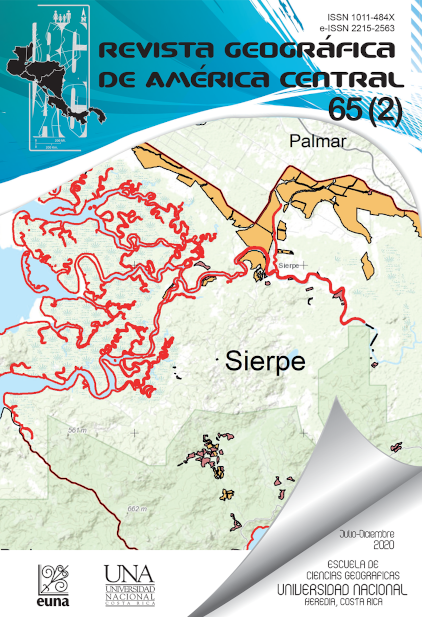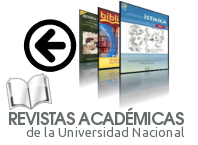Soy, glyphosate and human health. Some evidence in the Argentinian Dry Chaco Region (1990-2012)
DOI:
https://doi.org/10.15359/rgac.65-2.6Keywords:
Soy, Glyphosate, Human health, Argentine Dry Chaco RegionAbstract
In the last decades of the 20th century and the first decades of the 21st century, the Argentinian Dry Chaco Region (also known as Chaco Salteño or Umbral al Chaco), went through an intense process of deforestation associated with the advance of the agricultural frontier. The transgenic soybean-glyphosate agrotechnological package was the main protagonist of this process. In the broad ongoing debate pertaining to the effects of glyphosate on human health, epidemiological evidence on this relationship is not enough. That is why this article focuses on the use of mortality statistics, and therefore, its main contribution will be to make a first approach to the study of the epidemiological profile evolution of the region associated with the use of said package
References
Álvarez, C., Reynoso, M. V., Gómez, D., León, R., Canales, A. & Feria, A. (2014). Comparision of the in vivo and in vitro genotoxicity of glyphosate isopropylamine salt in three different organisms. Genetics and Molecular Biology, 1 (37), 105-110.
Anadón, A., Martínez Larrañaga, M. R., Martinez, M. A., Castellano, V., Martínez, M., Martin, M. & Bernal, J. (2009). Toxicokinetics of glyphosate and its metabolite aminomethyl phosphonic acid in rats. Toxicology Letters (190), 91-95.
Benachour, N. & Seralini, E. (2009). Glyphosate Formulations Induce Apoptosis and Necrosis in Human Umbilical, Embryonic, and Placental Cells. Chemical Research in Toxicology (22), 97-105.
Bravo, E. (2015). Un mal cabalga con el viento. La toxicidad y carcinogenicidad del glifosato. Quito: Third World Network.
Bravo, A.; Rodríguez, J.; Centurión Mereles, H.; Domínguez, D.; Bravo, M.; Sabatino, P.; & Poth, C. (2010). Los señores de la soja: la agricultura transgénica en América Latina. CICCUS - CLACSO: Buenos Aires.
Bruniard, E. (1975/78). El gran Chaco argentino. UNNE: Resistencia.
Carrasco, A. (2010). Glyphosate-Based Herbicides Produce Teratogenetic Effects on Vertebrates by Imparing Retinoic Acid Signaling. Chemical Research in Toxicology (23), 1586-1595.
CNIA. (2009). Evaluación de la información científica vinculada al glifosato en su incidencia sobre la salud humana y el ambiente. Buenos Aires: Comisión Nacional de Investigaciones sobre Agroquímicos-CONICET.
Córdoba, A.; Leal, G. & Martínez, C. (1989). El problema del diagnóstico médico en la investigación de la mortalidad por causa. En R. Jiménez Ornelas, Investigación multidisciplinaria de la mortalidad y morbilidad en niños menores de cinco años (Primer Seminario de Demografía Formal). México DF: UNAM / Centro de Investigaciones Multidisciplinarias, 39-46.
Domínguez, D. I. & Sabatino, P. (2010). La muerte que viene en el viento. La problemática de la contaminación por efecto de la agricultura transgénica en Argentina y Paraguay. En A. L. Bravo, H. Centurión, D. I. Domínguez, P. Sabatino, C. M. Poth, & J. L. Rodríguez, Los señores de la soja. La agricultura transgénica en América Latina (págs. 31-122). Buenos Aires: CLACSO.
EPA. (1997). Glyphosate; Pesticide Tolerances. Enviromental Protection Agency. US Federal Register.
Fernandez, J., Wechsler, S., Livingston, M. & Mitchell, L. (2014). Genetically Engineered Crops in the United States. United States Department of Agriculture, Economic Research Service. Economic Research Report.
Frenk, J., Frejka, T., Bobadilla, J. L., Stern, C., Lozano, R., Sepúlveda, J. & José, M. (1991). La transición epidemiológica en América Latina. Bol. of. Sanit. Panam. 111, (6)
Giarracca, N. y Teubal, M. (2006). Democracia y neoliberalismo en el campo argentino. Una convivencia difícil”, en GRAMMONT, H. (Ed.) La construcción de la democracia en el campo latinoamericano. Buenos Aires, CLACSO, Consejo Latinoamericano de Ciencias Sociales.
Gómez, S. (2017). Usos del territorio, acumulación por desposición y derecho a la salud en la Argentina contemporánea: el caso de la soja transgénica. Geographia, XIX (39), 3-15.
Ibáñez, M. (2002). ¿Qué usan en Colombia? El nuevo agente naranja. Efectos sobre la salud y el ambiente de herbicidas que contienen glifosato. En .
IARC-OMS. (2015). Carcinogenicity of tetrachlorvinphos, parathion, malathion, diazinon and glyphosate. IARC Monographs.
ISAAA. (2017). Global Status of Commercialized Biotech/GM Crops in 2017: Biotech Crop Adoption Surges as Economic Benefits Accumulate in 22 Years. ISAAA Briefs (53).
Mañas, F., Peralta, L., Ugnia, L., Weyers, A., García, H., & Gorla, N. (2013). Oxidative stress and comet assay in tissues of mice administered glyphosate and AMPA in dringking water for 14 days. Journal of Basic & Applied Genetics, XXIV (7), 67-75.
Morales, M. Á. M., Peña, E. Z., Mesa, A. C., Machado, D., & Álvarez, R. C. (2005) Clasificación Internacional de Enfermedades y Problemas relacionados con la Salud.(CIE). Estudio comparativo entre revisiones sucesivas CIE-9 & CIE-10. Experiencia Cubana. La Habana.
Organización Panamericana de la Salud (OPS). (2017). Lineamientos básicos para el análisis de la mortalidad. Washington, D.C.
Ortega, L. (2014). La soja y el debate sobre el desmonte. Documentos de CEIA (10), 43-59.
Paolasso, P., Krapovickas, J. & Gasparri, N. I. (2012). Deforestación, Expansión Agropecuaria y Dinámica Demográfica en el Chaco Seco Argentino Durante la Década de los Noventa. Latin American Research Review, 47 (1), 35-63.
Pengue, W. (2003). El glifosato y la dominación del ambiente. Biodiversidad (37), 1-7.
Pizarro, J. (2003). La evolución de la producción agropecuaria pampeana en la segunda mitad del siglo XX. Revista Interdisciplinaria de Estudios Agrarios (18), 63-125.
Rodríguez, J. (2010). Consecuencias económicas de la difusión de la soja transgénica modificada en Argentina, 1996-2006. En A. L. Bravo, H. F. Centurion Mereles, D. I. Domínguez, P. Sabatino, C. M. Poth, & J. L. Rodríguez, Los señores de la soja. La agricultura transgénica en América Latina (págs. 155-258). Buenos Aires: CLACSO.
Rofman, A. (1999). “Modernización productiva y exclusión social en las economías regionales”. Revista Realidad Económica, N ° 162, Argentina, Ed. IADE.
Samsel, A. & Seneff, S. (2013). Glyphosate's Suppression of Cytochrome P450 Enzymes and Amino Acid Biosynthesis by the Gut Micribiome: Pathways to Modern Diseases. Entropy (15), 1416-1463.
Schinasi, L. & Leon, M. (2014). Non-Hodgkin Lymphoma and Occupational Exposure to Agricultural Pesticide Chemical Groups and Active Ingredients: A Systematic Review and Meta-Analysis. International Journal of Enviromental Research and Public Health (11), 4449-4527.
Teubal, M. (2006). “Expansión del modelo sojero en la Argentina”, en Revista Realidad Económica, Nº 220, Bs. As.
Torrella, S. A. & Adámoli, J. (2005). Situación ambiental de la ecorregión del Chaco Seco. En La situación ambiental Argentina, 2005, 73-75.
Unión Europea. (2017). Preguntas y respuestas: la Comisión responde a la Iniciativa Ciudadana Europea sobre el glifosato y anuncia más transparencia en las evaluaciones científicas. Estrasburgo: Unión Europea. Hoja informativa.
Van Dam, C. (2002). Ocupación, degradación ambiental, cambio tecnológico y desarrollo sostenible: los efectos de la introducción del paquete soja/siembra directa en el chaco salteño. Tesis de Maestría, FLACSO.
Williams, G., Kroes, R. & Munro, I. (2000). Safety Evaluation and Risk Assessment of the Herbicide Roundup and Its Active Ingredient, Glyphosate, for Humans. Regulatory Toxicology and Pharmacology (31), 117-165.
Downloads
Published
How to Cite
Issue
Section
License
Proposed policy for journals offering Open Access
Authors publishing their works in the Journal acknowledge and agree to the following terms:
a) Authors retain the copyrights to their works and guarantee the Journal the right to be the first to publish their works, under the Creative Commons License Attribution-NonCommercial-ShareAlike 4.0 International, CC BY-NC-SA 4.0 International (https://creativecommons.org/licenses/by-nc-sa/4.0/deed.es), which allows others to share works upon complying with the acknowledgment of authorship and mention of the Journal as the original publisher of the work.
b) Authors are permitted to separately establish additional agreements for the non-exclusive distribution of the official edition of the work published in the Journal (for example, authors may desire to place the work in an institutional repository or incorporate it into a book that is to published elsewhere) so long they acknowledgment to recognize the Journal as the original publisher. The aforementioned additional agreements must respect the terms of the non-profit character and sharing philosophy of the original license (CC BY-NC-SA 4.0 International, https://creativecommons.org/licenses/by-nc-sa/4.0/deed.es).
c) Authors are encouraged to archive the post-print or editor/PDF version in Open Access repositories.







 REVGEO is licensed under https://creativecommons.org/licenses/by-nc-sa/4.0/deed.es
REVGEO is licensed under https://creativecommons.org/licenses/by-nc-sa/4.0/deed.es
.svg_4.png)

_(1).png)
_(1)_(1)_(1)_1.png)
(2)(1)(1)(1).png)
